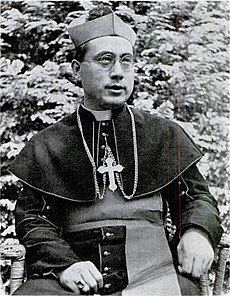See Archdiocese of Nanking Name Paul Pin Created cardinal April 28, 1969 Coat of arms Ordination December 22, 1928 | Denomination Roman Catholic Consecration September 20, 1936 Nationality Chinese Role Cardinal Books Eyes east | |
 | ||
Rank Cardinal-Priest of Gesu Divin Lavoratore Born April 13, 1901 ( 1901-04-13 ) Motto restaurare omnia in christo Died August 16, 1978, Rome, Italy Education Pontifical Urban University | ||
Synd 19 8 78 funeral mass at the vatican for chinese cardinal paul yu pin archbishop of nanking
Cardinal Paul Yü Pin (于斌; Hanyu pinyin: Yú Bīn; April 13, 1901 – August 16, 1978) was a Chinese Cardinal of the Roman Catholic Church. He served as Archbishop of Nanking from 1946 until his death, having previously served as its Apostolic Vicar, and was elevated to the cardinalate in 1969.
Contents
- Synd 19 8 78 funeral mass at the vatican for chinese cardinal paul yu pin archbishop of nanking
- Biography
- Trivia
- References
Biography
Paul Yü Pin was born in Hai-lun, Kirin, to Shuayuan Yu Pin and Ai-mei Siao. Orphaned at age 7, he was baptized in 1914 after encountering the missionary priests near Lansi, where he lived with his grandfather. Yu attended the Provincial Normal School in Heilongjiang, the Jesuit Aurora University in Shanghai, and the seminary in Kirin before going to Rome, where he studied at the Pontifical Urbaniana University (earning his doctorate in theology) and Pontifical Roman Athenaem S. Apollinare. He also studied at the Royal University in Perugia, from where he obtained a doctoral degree in politics.
Yu was ordained to the priesthood on December 22, 1928 by Archbishop Giuseppe Palica, and then taught at the Urbaniana University until 1933, when he returned to China. Upon his return, he was named National Director of Catholic Action, secretary of the Chinese nunciature, and Inspector General of Catholic schools in China.
On July 17, 1936, Yu was appointed Apostolic Vicar of Nanking and Titular Bishop of Sozusa in Palaestina by Pope Pius XI. He received his episcopal consecration on the following September 20 from Archbishop Mario Zann, with Bishops Simon Tchu, SJ, and Paul Montague, CM, serving as co-consecrators, in Beijing. In 1937, the Imperial Japanese Army took Nanking and a reward of $100,000 was placed for the capture of Yu, who spent World War II in the United States. There he planned in 1943 to establish employment bureaus, available to American teachers, doctors, and technicians, in China. Also that year, the Chinese cleric supported two bills before the House Immigration Committee that allowed Chinese to enter and become citizens of the United States under the quota system. Yu, following his return to China, was promoted to the rank of a Metropolitan Archbishop when his vicariate was elevated as such by Pope Pius XII on April 11, 1946.
In 1949, the new Communist regime expelled him from his see, and he was yet again forced to leave the country, resuming his exile in the United States. During this time, the Archbishop dedicated himself to helping Chinese Americans and raising funds for refugees from Communist China in Taiwan, where he was made rector magnifico of Fu Jen Catholic University in 1961. Yu attended the Second Vatican Council from 1962 to 1965, and was created Cardinal Priest of Gesù Divin Lavoratore by Pope Paul VI in the consistory of April 28, 1969. Upon his resignation as Fu Jen's rector on August 5, 1978, the Cardinal was named its Grand Chancellor. In 1976 he had become the first director of Dharma Realm Buddhist University's Institute for World Religions (now attached to Berkeley Buddhist Monastery).
He died from a heart attack at age 77 in Rome, where he had gone to participate in the conclave following Pope Paul VI's death in August 1978. Yu is interred in a mausoleum on the campus of Fu Jen Catholic University in Xinzhuang, Taipei County.
